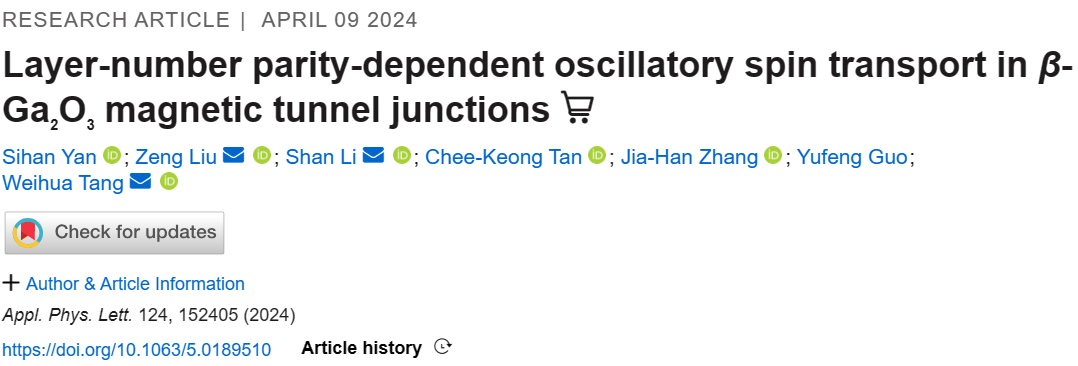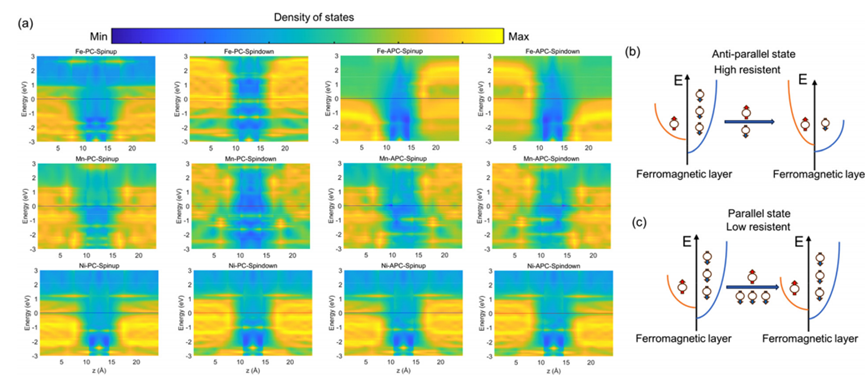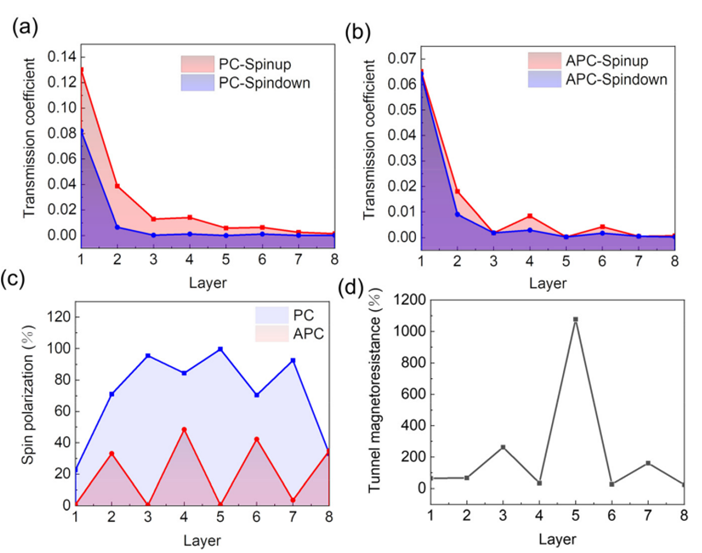

【Member Papers】Tang Weihua's Team at Nanjing University of Posts and Telecommunications: The Transport Property of β-Ga₂O₃ Magnetic Tunnel Junctions were Revealed Based on Non-Equilibrium Green's Function
日期:2024-09-20阅读:594

Recently, based on the calculation method of the non-equilibrium Green’s function, the researchers of Tang Weihua's group in the College of Integrated Circuit Science and Engineering of Nanjing University of Posts and Telecommunications predicted the spin transport of the magnetic tunnel junction based on β-Ga2O3 under different ferromagnetic layer and different insulation layer thickness, and obtained the spin polarizability and Tunneling Magnetoresistance of the system. And found that there may be a spin transport property that oscillates with the number of layers. This opens up a novel way to expand the application of Gallium Oxide in spintronics.
The authors use the (100) crystal face of β-Ga2O3 single crystal, which has the potential to peel off easily, as the insulating layer of the magnetic tunnel junction, and adopt Fe, Mn, Ni as the ferromagnetic layer. Under different ferromagnetic layer conditions, the magnetic tunnel junction obtains different spin-resolved spin tunneling potential barriers, as shown in Figure 1. It can be seen that the tunneling potential barriers of Fe and Mn in different spin directions are quite different in the parallel state, and their TMR reaches 64% and 225% respectively.

Figure 1. (a) The PLDOS of Fe, Ni, and Mn as ferromagnetic layers along the transport direction in spin-resolved monolayer β-Ga2O3 MTJs. The schematic diagram showing the electron tunneling process with different spin directions in (b) antiparallel state and (c) parallel state.
Figure 2 illustrates the transmission coefficient, spin polarizability and TMR with Fe/(100) β-Ga2O3/Fe insulation layer number. It can be seen that the spin transport property of this system will oscillate in an odd-even dependence with the number of layers. The TMR is at the minimum value when the number of layers is even, and the TMR is at the maximum value when the number of layers is odd. At the same time, the theoretical maximum of 1077% TMR is achieved when the number of layers is 5. The source of this phenomenon may be the spin-resolved layered tunnel barrier in the system, which is mainly contributed by oxygen atoms, as shown in Figure 3. At odd layers, an even layer tunnel barrier is formed, and an odd layer tunnel barrier is realized at even layers. Through the Wenzel-Kramers-Brillouin approximation, it is proved that the exchange interactions of barriers between different layers superposition and cancel each other, resulting in the parity oscillation of TMR.

Figure 2. The spin-resolved transmission coefficients related to the thickness in (a) parallel state and (b) antiparallel state; (c) Spin polarization of Fe/β-Ga2O3/Fe MTJ and (d) tunnel magnetic resistance.

Figure 3. The PLDOS of the (a)-(d) spin-up and (e)-(f) spin-down electrons in the antiparallel states of the 2-5 layer beta-Ga2O3 MTJs. The white dashed line and the black dashed line respectively represent approximate intra-layer and inter-layer tunneling barriers.
In addition, the current and transport property of the β-Ga2O3 MTJ system in non-equilibrium state are further calculated, as shown in Figure 4. It can be seen that with the rise of voltage, the tunnel current has a significant nonlinear change, which leads to the plunge and fluctuation of TMR, and the suitable working range of the TMR system is predicted to be 0~20mV. This phenomenon may be caused by higher electron energy and spin flipping due to bias voltage.

Figure 4. Spin-resolved currents for (a) parallel and (b) anti-parallel states, (c) spin polarization and (d) TMR for parallel and anti-parallel states
Team Introduction
Tang Weihua, professor and doctoral supervisor of College of Integrated Circuit Science and Engineering (College of The Integration of Industry and Education), Nanjing University of Posts and Telecommunications. Prof. Tang is one of the leading figures in the field of wide band gap semiconductor Gallium Oxide materials and devices in China. He has presided over more than 20 key projects at the national and provincial level, including the National Key Research and Development Program of China, the Major Program of National Natural Science Foundation of China, Beijing Major Science and Technology Projects, and the Jiangsu Entrepreneurship and Innovation Team Project. He has published more than 400 SCI indexed papers in important domestic and international academic journals, enjoyed the special government allowance of The State Council, has been selected in the national "New Century Hundred Million Talents Project", Chinese Academy of Sciences "Hundred Talents", Jiangsu Province "Entrepreneurship and Innovation Talent", Jiangsu Province "Entrepreneurship and Innovation Team" leading talents, and won the first prize and second prize of Beijing Science and Technology.
Liu Zeng, a researcher and master's supervisor of the College of Electronic Information Engineering, Inner Mongolia University, was selected into the High-Level Talent Introduction Plan of the Steed Plan of Inner Mongolia University. He is mainly engaged in the research of wide band gap semiconductor optoelectronic devices and physics, has hosted or participated in the National Key Research and Development Program of China, the Major Program of National Natural Science Foundation of China, and the National Science Fund for Distinguished Young Scholars, etc. He has published over 50 papers in journals such as Applied Physics Letters, IEEE Electron Device Letters, IEEE Transactions on Electron Devices, IEEE Photonics Technology Letters, The Journal of Physical Chemistry Letters, Cell Reports Physical Science, Advanced Optical Materials, Optics Letters, Journal of Physics D, and Journal of Applied Physics.


